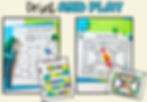Subtraction Games for Kindergarten and First Grade to 10 and 12
- Lara
- Apr 26, 2024
- 4 min read
Subtraction games can be a little trickier than addition games because with addition games you get two or three dice and you're good to go. But with subtraction, it can be tricky because we do not want to get into negative numbers with, Kindergarten, 1st Grade, or 2nd Grade students. So you have to be more thoughtful about the games that you have your kids do.
Spin and Subtract
In Spin and Subtract have your students start with a full 10-frame and spin their spinner. The number they spun would be the number that they take off of the 10-frame. Then they have the opportunity to write a subtraction equation that goes with what they just did, so that they can get practice with their number writing, equation writing, and it's helpful for you to be able to see what they're doing and how they're doing, and if there's any confusion with writing equations and symbols.
Spin, Roll, and Color Print and Play Subtraction Game
The next game is called Spin Roll and Color. For this game, spin the spinner, and then build a tower to match it if they want that visual, then roll one die, and then subtract the number they rolled from the number they spun, and then they can color in that number or space. Their recording sheet is kind of like a grid, so it has all of the numbers on the bottom, and then they would just color in one box for the difference that they got, and then they're looking to see which difference will reach the top first or whenever they finish their grid.
If you use two dice, you will want to talk to students about how to determine if the number that you rolled is bigger than the number you spun, then you might have to start that roll over again.
Build, Roll, and Break: Tower and Dice Subtraction Game
The next printable subtraction game is called Build, Roll, and Break and for that one, students build a tower of 12 and then roll two dice. They'll have to find the sum of the two dice, subtract that from the tower, and break off the tower where the sum is, then write an equation to go with it. They have a game board so they have to fill up the game board to get to the finish line to finish that game, Build, Roll, and Break.
My students enjoyed that game because they like to build towers and think it's fun to break them off gently. We're not going too crazy here the cubes can be pretty tough.
Spin, Roll, and Remove
The next subtraction game is similar to Spin, Roll, and Color, this one is Spin, Roll, and Remove. The idea is the same. They spin, roll, and subtract whatever number they roll and then remove it from their tower. In this game, the focus is more on writing equations, whereas the other is just finding the difference.
So they're practicing finding the difference and writing a matching equation. Since the idea is similar, students can do this station independently as it will be familiar to them, but they come at it from a different angle, so they're working on other skills.
Jump Around
The last one is my favorite, it's called Jump Around. Jump Around is a partner game. In this game, students spin to get their starting number. Then roll their die and subtract the number they rolled from the number they spun. The thing that's a little trickier about this game is that there's not necessarily built in a place for them to model the subtraction.
They would have to keep the numbers in their head or use their fingers. So it's more challenging than the other subtraction games, which is why I said it last. The reason that it's called Jump Around is that on their game board, there are all the different differences they might have. They are looking for the difference they got and jumping around to any number on the board to find it, and then they can color it in. With whatever color that they choose, so maybe one player is the blue player, one player is the green player, and so they would color in all of their spots blue, their partner would color in all of their spots green, and then at the end, they're trying to figure out who got the most spots.
As for the numbers on the game board, I tried to pick more common differences, so they're not rolling and spinning and spinning and spinning trying to get an uncommon number.
Again, it's a little bit trickier because they have to keep the number they're using in their head. They might have spun a 10 and rolled a 3 so they could either count up or count back to figure out what the difference was. This game is fast-paced and, a little bit more intense, but of course, if they need it, you can offer them, a 10-frame to use or cubes to use to support them and model the subtraction.
Some of these games have the print-and-go version where you can print and color it. Others have a print-and-go version and a color version so you could laminate them and then reuse them.
I hope you have some new ideas for hands-on, low-prep subtraction games.
And until then, I will catch you next time.
If you are looking for Addition and Subtraction Games you can get them here!




